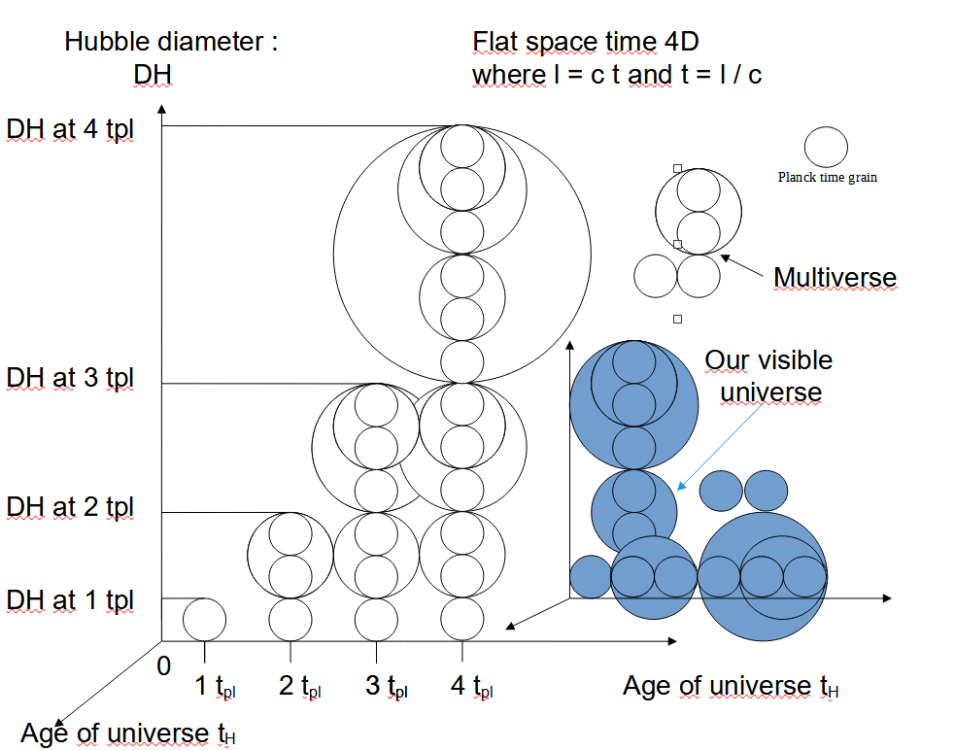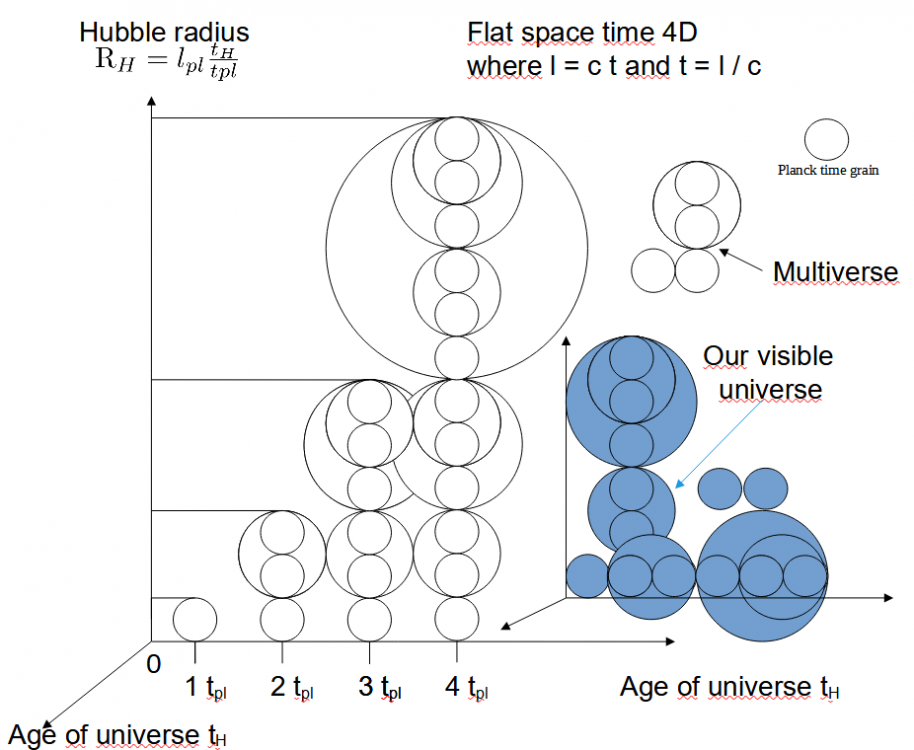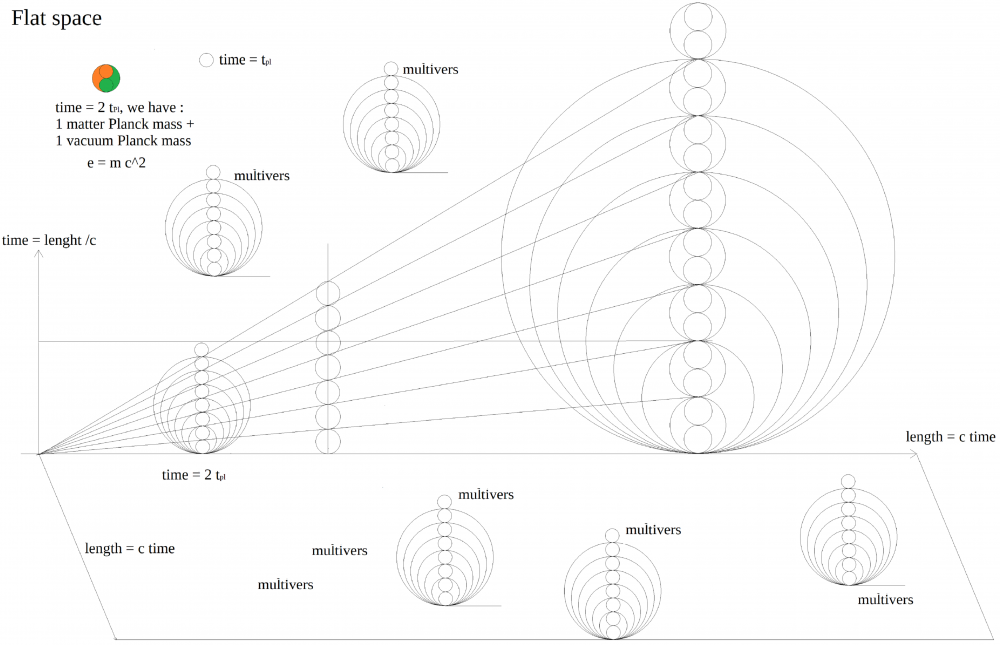Everything posted by stephaneww
-
why this egality is exact please ?
-
why this egality is exact please ?
hello swansont thank you for your relevant criticism this formula is indeed incorrect RH = (1+2+3+...+tH) lp the sigma summation : RH = (1 tp/tp+2 tp/tp+3 tp/tp+...+tH/tp) lp if I am not mistaken, corresponds to the diagram
-
why this egality is exact please ?
hi we forget the last two messages and try to move on MH=(1+2+3+4+5+...+tH) 1/2mpl RH=(1+2+3+4+5+...+tH) lpl Expansion and acceleration of the expansion of the visible universe. time = 1/H , It can exist before tPl or t = 0. The distances of the 3D flat space increase with time.
-
Universe is (In)Finite?
The problem is that your proposal, as interesting as it could be, is not supported by equations. This is more philosophy, not science....
-
why this egality is exact please ?
-
why this egality is exact please ?
Hi, what do you think about this figure please ? in my opinion it is closely related to the equality introduced at the beginning of this tread. it lacks a caption for the moment, I will do my best to explain what i think it means according to your possible questions. time = 1/H , It can exist before tPl. The distances of the 3D flat space increase with time.
-
Universe is (In)Finite?
Hi swansont I'm not the author of this arxiv paper. Mine is on viXra
-
Universe is (In)Finite?
why exponentially ? Indeed it is excessive. If you want to do maths look here https://arxiv.org/pdf/2109.11953.pdf, with length = time c. This formula is valid in QM and in general relativity. It is acceptable it seems to me: at the Hubble radius, the visible universe, we can consider that the universe can be assimilated to a black hole (ingredients: mass of the universe, Hubble radius, Schwarzchild radius formula, critical density) For the moment this physics does not exist. I started a topic on this subject which has little echo for the moment. This is normal because it is still full of errors. My model is under construction, I'm just starting to tame it Which radius ? The observable radius ? The Hubble radius ? expand exponentially ,why not an infinite power? You need formulas and values that correspond with the data that comes from what you observe. Try to put more math and dimensional values to clarify your thinking. Your "fundamental laws of physics" remain to be defined and they must be compatible with relativity and QM, just as classical mechanics is included in general relativity. I have more difficulty understanding the rest of the message... I agreed I think I found an answer to this question beecee . Give me a little more time: I need drawings and I'm slow to make them. ... and have a look here https://arxiv.org/pdf/2109.11953.pdf,
-
Universe is (In)Finite?
You have to prove it with a theory, mathematics and numbers. Especially mathematics so that it is verifiable and therefore scientific. For the moment I only read words, which is not enough to convince on this forum. Moreover your words are not well arranged to have a real physical meaning. Do you have any knowledge in mathematics? If so, offer them with relations as I try to do here. Otherwise, this discussion will not be productive here. For the moment we don't know how to deal with infinities in physics. There has been a recent arxiv paper on this subject and I'm watching what might come of it.
-
Universe is (In)Finite?
interesting question that needs a mathematical answer from you 😉 Our current physical knowledge is limited by the following Planck units: time, length, mass, temperature for the 4 main ones. (I can forget some). Any physical description of the micro is made from mathematical relations between these units. If you can figure out how we get from the micro to the cosmos, you will have something verifiable. On the other hand, if you try to find out what happens before that wall, "you'll be stuck with the wall". It will be unverifiable. As for the rest of your message, I find it hard to make sense of it...
-
Universe is (In)Finite?
Ok, badly said indeed. Before Planck's time relativity says nothing. This is the way I was trying to formulate it.
-
Universe is (In)Finite?
Hi, This is because singularities are questions of quantum mechanics. Probably because the universe is homogeneous over large distances if I am not mistaken, right? Indeed and it is probably because our understanding of the universe is limited by its visible part. The vision of a flat universe today echoes the vision of a flat earth of the ancients, because limited by their fields of vision. Interesting reflection within the framework of my toy cosmological model speculative consistent with the LambdaCDM model. So I agree with you on this point. I would rather say that we have the wrong frame of reference. The latter should be, in my opinion quantum, and to be defined. However, we are limited when we want to go back before the Big Bang. In this case, general relativity does not make sense, it is not applicable. I agree with Phi for All on this point, it is well established.
-
Beginning of a theory of everything in cosmology ?
and I made also an error in the formula 😡: there was an extra square in the denominator note that now the equation has the dimension of an energy
-
Beginning of a theory of everything in cosmology ?
sorry I made a mistake : the egality (1) is in m-2 the egality (2) in Joules precision on the question of the dimensions : in the egality (1) it is because we have a singularity and in the egality (1), two square surfaces. so with this presicions : can you please confirm that : the egality (2) give the exact numerical value of Planck energy? and that the egality (1) is a good approximation of the measurements of mesures of cosmological constant ? thanks in advance
-
Beginning of a theory of everything in cosmology ?
ooops I forget because the question of dimensions we have: (1) ρvac in m-2 when tH is big enough (2) ρvac in kg/m3
-
Beginning of a theory of everything in cosmology ?
Hello it is again a function of Hubble time tH =1/H as here : https://www.scienceforums.net/topic/125960-why-this-egality-is-exact-please/ you will not have the referential immediately, so don't contest with dimensional analysis please. here his equation, you will adapt the dimensions: [math]\rho_{\text{Vacuum at }t_H}= \frac{1}{ \vartheta} \frac{ G \text{ }m_{Pl}^2}{ (t_H\text{ }c)^2} [/math] with : [math] \vartheta=2 [/math] if tH>tPl (1) and [math] \vartheta=1 [/math] if tH=tPl (2) can you please confirm that : (2) give the exact numerical value ? and that (1) is a good approximation of the measurementsis a good approximation of mesures ? thanks in advance stéphane
-
why this egality is exact please ?
thank you swansont. it saved me a lot of unnecessary research. 😊
-
why this egality is exact please ?
Hello beecee and thank you for your return Indeed it is not evident... ... but, I may have understood what the researcher told me. For the singularity at Planck time, one should consider the Boltzman constant kB with only one degree of freedom (=singularity =single particle?) at Planck temperature. Its energy in joules would be : Eth=1/2 kB TPl = 1/2 mPl c2 One would thus find for each mass o = 1/2 mPl its thermal energy thanks to c2. It would be in this sense that to speak of mass instead of energy would be improper. Does it make sense like that ? If we can take this step, we can examine how this model would be compatible with the expansion. note, use a translator : Eth=1/2 kB T for one degree of freedom, it is not available in english version Hi joigus I don't know how to answer that. I only discuss mass (=energy) at the moment.
-
why this egality is exact please ?
Thank you swansont. I think I have transcribed wrongly what the researcher told me. Here is what it looks like with a web translator "it is inevitable that at Planck time, the temperature (in units k_B T) is equal to the Planck mass (multiplied by the speed of light squared), and that the horizon at that time contains only about a single particle. In other words, this is not a coincidence, it is simply a consequence of the dimensional analysis that can be performed with the quantities c, hbar and G". was the singularity a "plasma" at Planck temperature as I think with your add? That could help me to correct my mistakes..
-
why this egality is exact please ?
I need time to answer your counter argument about the nucleon and the Planck mass. this is a new area for me. please excuse my delay in answering. i will be back as soon as possible.
-
why this egality is exact please ?
so there is indeed in addition to the mass at Hubble radius an additional correspondence with the ΛCDM model?
-
why this egality is exact please ?
Ok I don't know the name of the propriety I want describe Consider this diagram 1, 2, 3, 4, 5 are radius of their Hubble sphere in each direction of the ray (1, 2, 3, 4, 5), wherever you look in the visible universe, they are identical with the same number of masses o what does this correspond to in the standard cosmological model ? there should be a match in my opinion, normally. there must be one in my opinion normaly it's your turn to give your knowledge 🙃 please develop, I don't undertand where there is a problem (formulas + values in J or kg) bonus: do you agree that my model gives the actual number of nucleon in the visible universe with 1 nucleon at the beginning of the universe (big bang)?
-
why this egality is exact please ?
oops I made an error me too. I wanted to say "Isotropie"
-
why this egality is exact please ?
Hello joigus, As usual it's a pleasure to read you 😊 yes, you will find exactly the same thing in my pdf virax. it makes sense? Don't worry, I do a thousand a day, you're excused 🙂 My model/egality explains the homogeneity of the visible universe no? do you agree? this also explains why we not found the other half of the mass of the visible universe, no? Yes, I agree with both of you. Besides, the researcher of the cnrs told me that to speak of mass at the moment of the big bang was improper. Prefer the notion of energy (mPl c2) for what I express improperly with the Planck mass. I use the notion of mass for the simplification of the calculations I think I've finished my edit. You can answer without that its problem for me☺️
-
why this egality is exact please ?
I don't know why the researcher of the cnrs told me that at the time of the big bang we had a primitive atom (nucleon). I am only an amateur but it is consistent with the primitive atom of the big bang. I think but I am not sure that it is related to the mass of the nucleon and its Planck temperature at the time of the big bang which makes the energy also equal to mPl c2. Is it coherent like that please? What I am sure of is that my model is consistent with the standard cosmological model: it allows us to find the number of nucleons in the actual visible universe and explains why the energy of the universe (m c2) increases with time in violation of the principle of conservation of energy. I don't know about the other fields of physics. In this thread we talk about cosmology. another thing: we can advantageously replace the figure 2 quoted above by this diagram which clarifies the model time tPl ( in seconds) = 1/H ^ | o | o o | o o o | o o o o | o o o o o 0 1 2 3 4 5 -----> age in number of tPl o is the mass mPl/2 associeted to age and grain of time tPl





